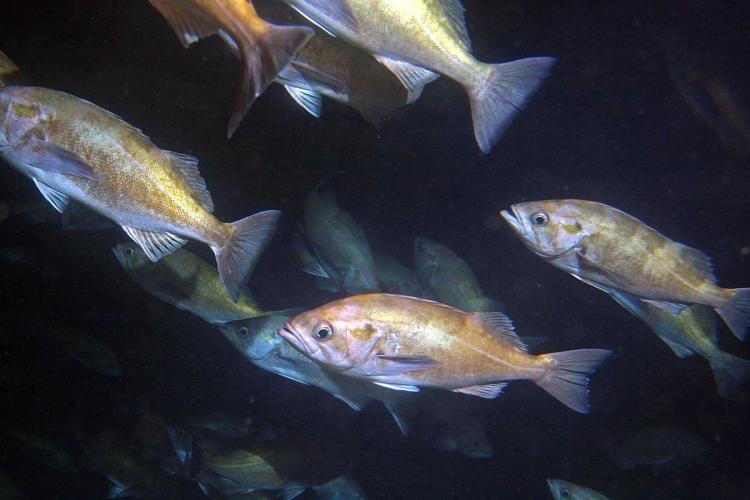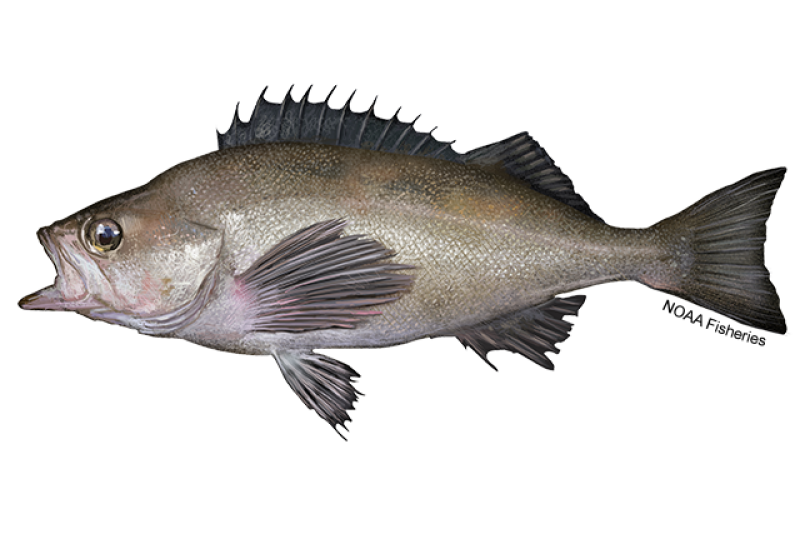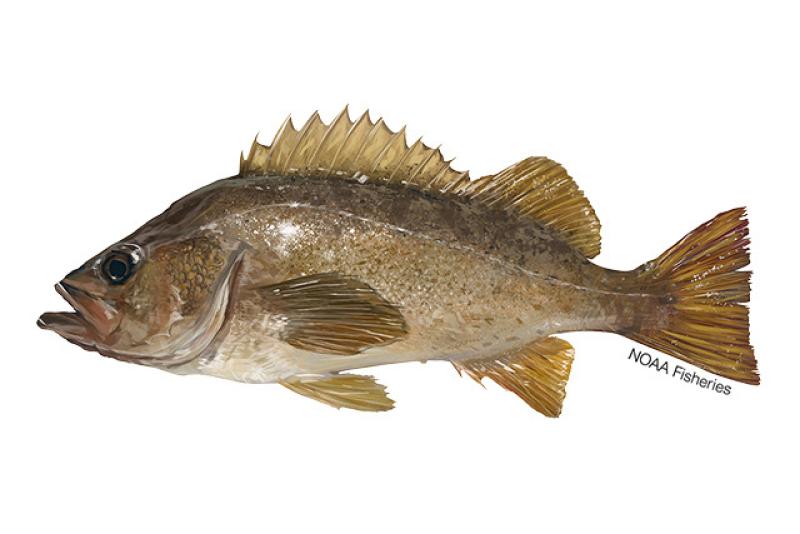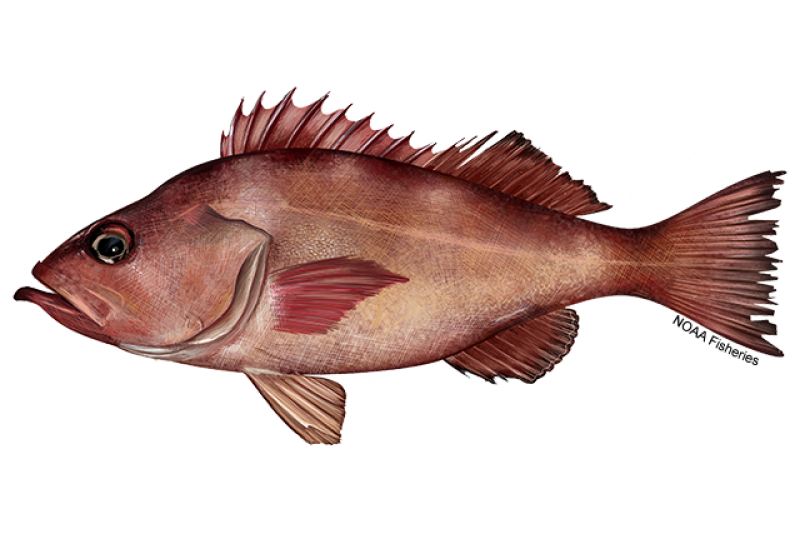 A school of widow rockfish in Soquel Canyon, Monterey Bay. Credit: Diana Watters, Southwest Fisheries Science Center
A school of widow rockfish in Soquel Canyon, Monterey Bay. Credit: Diana Watters, Southwest Fisheries Science Center
A school of widow rockfish in Soquel Canyon, Monterey Bay. Credit: Diana Watters, Southwest Fisheries Science Center
About the Species
 A school of widow rockfish in Soquel Canyon, Monterey Bay. Credit: Diana Watters, Southwest Fisheries Science Center
A school of widow rockfish in Soquel Canyon, Monterey Bay. Credit: Diana Watters, Southwest Fisheries Science Center
A school of widow rockfish in Soquel Canyon, Monterey Bay. Credit: Diana Watters, Southwest Fisheries Science Center
U.S. wild-caught widow rockfish is a smart seafood choice because it is sustainably managed and responsibly harvested under U.S. regulations.

Population
The Pacific Coast stock is not overfished.

Fishing Rate
Not subject to overfishing.

Habitat Impact
Most fishing gear used to harvest widow rockfish rarely contacts the ocean floor and has minimal impacts on habitat. Area closures and gear restrictions protect sensitive rocky, cold-water coral and sponge habitats from bottom trawl gear.

Bycatch
Regulations are in place to minimize bycatch of overfished and protected species.
Population Status
- There are two stocks of widow rockfish: Pacific coast and one stock contained in the Gulf of Alaska Other Rockfish Complex. According to the most recent stock assessments:
- The Pacific coast stock of widow rockfish is not overfished (2023 stock assessment) and not subject to overfishing based on 2022 catch data. Summary stock assessment information can be found on Stock SMART.
- Widow rockfish is managed as part of the Gulf of Alaska Other Rockfish Complex and has been assessed, but there is not enough information to determine the population size so the overfished status is unknown (2023 stock assessment). This complex is not subject to overfishing based on 2023 catch data. Summary stock assessment information can be found on Stock SMART.
Appearance
- Widow rockfish are dusky-brown with traces of light yellow and red.
- They have black fin membranes and a strongly slanted anal fin.
- They have weak or reduced (short) head spines and a mouth that is relatively small when compared to other rockfish.
Biology
- Widow rockfish reach lengths up to 24 inches and may live as long as 60 years, but fish older than 20 are uncommon.
- Males grow faster than females, but females reach larger sizes.
- Widow rockfish mature at about 8 years old or when they are about 16.5 inches long.
- Widow rockfish are internal fertilizers, and larvae are released alive in January or February.
- Juveniles feed on krill and copepods.
- Older fish feed on juvenile crabs, amphipods, krill, and small fish.
- Chinook salmon and northern fur seals feed on juvenile widow rockfish.
Where They Live
Range
- Widow rockfish are found between the Gulf of Alaska and northern Baja California.
- Adults are rarely seen in California and are most abundant from British Columbia to northern California.
Habitat
- Widow rockfish are found at depths ranging from 80 to 1,200 feet.
- Both juveniles and adults exist in large schools and are found above large jagged rocks and near cobblestone.
Fishery Management
- NOAA Fisheries and the Pacific Fishery Management Council manage the widow rockfish fishery on the West Coast.
- Managed under the Pacific Coast Groundfish Fishery Management Plan:
- Permits and limited entry to the fishery.
- Limit on how much may be harvested in one fishing trip.
- Certain seasons and areas are closed to fishing.
- Gear restrictions help reduce bycatch and impacts on habitat.
- A trawl rationalization catch share program that includes:
- Catch limits based on the population status of each fish stock and divided into shares that are allocated to individual fishermen or groups.
- Provisions that allow fishermen to decide how and when to catch their share.
- The Pacific Coast stock had been overfished and was successfully rebuilt in 2011.
- NOAA Fisheries and the North Pacific Fishery Management Council manage widow rockfish as part of the Gulf of Alaska Other Rockfish Complex.
- Managed under the Fishery Management Plan for Groundfish of the Gulf of Alaska:
- There is no directed fishery for this species in Alaska, and only minor amounts are landed incidentally in other fisheries.
Harvest
- In 2023, commercial landings of widow rockfish totaled approximately 24 million pounds and were valued at $6.3 million, according to the NOAA Fisheries commercial fishing landings database.
- The majority of the catch comes from Oregon and Washington and the remainder comes from California and Alaska.
- Gear types, habitat impacts, and bycatch:
- Primarily harvested with midwater trawl gear, which has minimal impacts on ocean bottom habitats. To a lesser extent, harvested with bottom trawl gear.
- Midwater and bottom trawls may sometimes catch other species of fish, including overfished and protected species.
- Gear restrictions, closed areas, and catch share programs limit when, where, and how much trawl fishermen can harvest to reduce bycatch of other species.
- Rockfish conservation areas eliminate fishing in areas on the West Coast where overfished rockfish species co-occur with target stocks, like widow rockfish. These closed areas help prevent bycatch of overfished rockfish.
- Widow rockfish are often caught incidentally in the Pacific whiting fishery
- Managers are working to reduce incidental catch through the use of annual catch limits and catch shares.
- Recreational anglers fish for widow rockfish, but they comprise only a minor part of recreational groundfish fisheries.
Scientific Classification
- Widow rockfish are found between the Gulf of Alaska and northern Baja California.
- Adults are rarely seen in California and are most abundant from British Columbia to northern California.
- Widow rockfish are found at depths ranging from 80 to 1,200 feet.
- Both juveniles and adults exist in large schools and are found above large jagged rocks and near cobblestone.
Fishery Management
- NOAA Fisheries and the Pacific Fishery Management Council manage the widow rockfish fishery on the West Coast.
- Managed under the Pacific Coast Groundfish Fishery Management Plan:
- Permits and limited entry to the fishery.
- Limit on how much may be harvested in one fishing trip.
- Certain seasons and areas are closed to fishing.
- Gear restrictions help reduce bycatch and impacts on habitat.
- A trawl rationalization catch share program that includes:
- Catch limits based on the population status of each fish stock and divided into shares that are allocated to individual fishermen or groups.
- Provisions that allow fishermen to decide how and when to catch their share.
- The Pacific Coast stock had been overfished and was successfully rebuilt in 2011.
- NOAA Fisheries and the North Pacific Fishery Management Council manage widow rockfish as part of the Gulf of Alaska Other Rockfish Complex.
- Managed under the Fishery Management Plan for Groundfish of the Gulf of Alaska:
- There is no directed fishery for this species in Alaska, and only minor amounts are landed incidentally in other fisheries.
Harvest
- In 2023, commercial landings of widow rockfish totaled approximately 24 million pounds and were valued at $6.3 million, according to the NOAA Fisheries commercial fishing landings database.
- The majority of the catch comes from Oregon and Washington and the remainder comes from California and Alaska.
- Gear types, habitat impacts, and bycatch:
- Primarily harvested with midwater trawl gear, which has minimal impacts on ocean bottom habitats. To a lesser extent, harvested with bottom trawl gear.
- Midwater and bottom trawls may sometimes catch other species of fish, including overfished and protected species.
- Gear restrictions, closed areas, and catch share programs limit when, where, and how much trawl fishermen can harvest to reduce bycatch of other species.
- Rockfish conservation areas eliminate fishing in areas on the West Coast where overfished rockfish species co-occur with target stocks, like widow rockfish. These closed areas help prevent bycatch of overfished rockfish.
- Widow rockfish are often caught incidentally in the Pacific whiting fishery
- Managers are working to reduce incidental catch through the use of annual catch limits and catch shares.
- Recreational anglers fish for widow rockfish, but they comprise only a minor part of recreational groundfish fisheries.
Scientific Classification
| Kingdom | Animalia | Phylum | Chordata | Class | Actinopterygii | Order | Scorpaeniformes | Family | Scorpaenidae | Genus | Sebastes | Species | entomelas |
|---|
Last updated by NOAA Fisheries on 03/21/2025
Featured News
 Recreational anglers fish for rockfish on a recreational fishing boat off Southern California. Photo: Mark Kalez
Recreational anglers fish for rockfish on a recreational fishing boat off Southern California. Photo: Mark Kalez
California Charter Boats Contribute to Rockfish Research, Support Sustainable Fishing
 Tuna swim in sunlight. Credit: iStock.
Tuna swim in sunlight. Credit: iStock.

 Fishermen aboard Miss Sue, of Newport, Oregon, haul in their catch of rockfish off the West Coast. Rockfish represent some of the most common groundfish off the West Coast, and several species have been rebuilt in recent years. Credit: John Rae.
Fishermen aboard Miss Sue, of Newport, Oregon, haul in their catch of rockfish off the West Coast. Rockfish represent some of the most common groundfish off the West Coast, and several species have been rebuilt in recent years. Credit: John Rae.
Seafood Facts

Is Widow Rockfish Sustainable?
U.S. wild-caught widow rockfish is a smart seafood choice because it is sustainably managed and responsibly harvested under U.S. regulations.
Availability
Year-round.
Source
U.S. wild-caught from the central Gulf of Alaska to northern Baja California.
Taste
Delicate, nutty flavor.
Texture
Lean with a medium-fine texture.
Color
Raw flesh varies from light pink or translucent, to pink, to red, and turns white when cooked.
Nutrition Facts
Servings: 1; Serving Weight: 100 g (raw); Calories: 94; Protein: 18.8 g; Total Fat: 1.6 g; Total Saturated Fatty Acids: 0.4 g; Carbohydrate: 0 g; Total Sugars: 0 g; Total Dietary Fiber: 0 g; Cholesterol: 35 mg; Selenium: 36.5 mcg; Sodium: 60 mgMore Information
Rockfish Recipes
Looking for some ways to add rockfish into your rotation? We have you covered with these recipes for grilled rockfish kebabs, coconut-crusted rockfish tacos, and more!

Last updated by NOAA Fisheries on 03/21/2025
Seafood News
 Credit: NOAA Fisheries and Partners
Credit: NOAA Fisheries and Partners
Part 2: Seafood Tips from the People Bringing You America's Seafood
 Commercial fishing boats lined up in Sitka, Alaska. Credit: Shutterstock.
Commercial fishing boats lined up in Sitka, Alaska. Credit: Shutterstock.
NOAA Fisheries Seeks Recommendations for Restoring American Seafood Competitiveness

Celebrate Seafood This Holiday Season

Part 1: Seafood Tips from the People Bringing You America's Seafood
Research
Rockfish Barotrauma and Recompression
Researchers examined the effectiveness of descending devices during use in recreational fishing on commercial passenger fishing vessels. This work found that all devices were largely effective at releasing rockfish back toward their depth of capture.
Fisheries Assessment and Modeling Research on California Salmon and Groundfish
Our team performs stock assessments and conducts research focused on improving fisheries management.
Last updated by NOAA Fisheries on 03/21/2025





